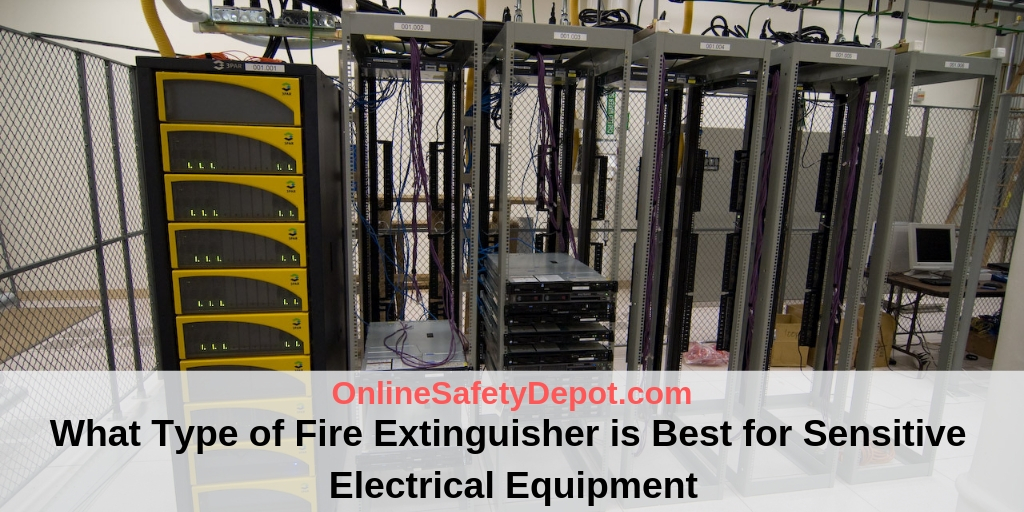What Type of Fire Extinguisher is Best for Sensitive Electrical Equipment
Every year, thousands of electrical fires occur in homes, data centers, server rooms, computer rooms, or any other environment where electrical equipment is present. Computers, servers, databases and many different electrical types of equipment are classified as Sensitive Electrical Equipment” and requires the use of specialized fire extinguishers to extinguish the fire without destroying or corroding the Sensitive Equipment.
What is the best type of fire extinguisher for Sensitive Electrical Equipment? Electrical fires require a class C fire extinguisher. For sensitive electrical equipment, such as computers, servers and data centers, Carbon Dioxide fire extinguishers, Halotron I are residue-free and easy to clean-up after it has been used and is nonconductive and doesn’t destroy the equipment.
Not all fires involve sensitive equipment or require a fire extinguishers that use residue-free agents like the Carbon Dioxide or Halotron I. Fires that occur in the home, such as the electrical outlets and cords, home appliances, or even the electrical panel box can use ABC Class Fire Extinguishers which are more versatile and better suit to extinguish most fires that may occur in the home.
Four Main Types of Fire Extinguishers
ABC Class Fire Extinguishers
The ABC class fire extinguishers are incredibly versatile due to its ability to extinguish Class A, Class B, and Class C fires as such, it is the most popular fire extinguisher in today’s market. The ABC class fire extinguishers are commonly found in most homes, businesses and public settings where Class A, Class B or Class C fires may occur.
To learn more about ABC Class Fire Extinguishers, consider reading our other article titled, “ABC Class Fire Extinguishers | Use, Classification and Model Designs.”
Halotron I
Halotron Fire extinguishers are one of the two fire extinguishers in today’s market that is designed to be used on sensitive electrical equipment as the agent used is considered a clean agent. However, the Halotron I Fire extinguishers can extinguish Class A, Class B, and Class C fires.
To learn more about Halotron Fire Extinguishers, consider reading our other article titled, “Halotron Fire Extinguishers | Use, Classification and Model Designs.”
Carbon Dioxide
Carbon Dioxide (C02) Fire Extinguishers uses a clean agent (C02) to extinguish fires. The Carbon Dioxide is residue-free making it an excellent option for sensitive equipment. Carbon Dioxide fire extinguishers are designed to extinguish Class B and Class C fires and are available in portable and wheeled designs.
To learn more about Carbon Dioxide Fire Extinguishers, consider reading our other article titled, “Carbon Dioxide Fire Extinguishers (C02) | Use, Classification and Model Designs”.
Purple K
Purple K Fire extinguishers contain a dry chemical, known as Potassium Bicarbonate, which is NOT a residue-free or considered to be a clean agent for sensitive electrical equipment. Purple K Fire extinguishers are designed to extinguish Class B and Class C fires.
Class B and C fires are common in gas stations, power plants, bars, auto repair shops, airports or aircraft service stations, industrial kitchens, warehouses, and any other area where electrical or flammable fires may occur.
To learn more about Purple K Fire Extinguishers, consider reading our other article titled, “Purple K Fire Extinguishers | Use, Classification and Model Designs.”
To better understand the types of fire extinguishers and the associated classification of fires, review the charts below.


Carbon Dioxide and Halotron I fire extinguishers are designed in Portable and wheeled (On and Offshore models) Below are some of the fire extinguishers that are currently available on OnlineSafetyDepot.com website.
Carbon Dioxide – Portable
Buckeye 5-pound Carbon Dioxide Fire Extinguisher
Buckeye 10-pound Carbon Dioxide Fire Extinguisher
Buckeye 15-pound Carbon Dioxide Fire Extinguisher
Buckeye 20-pound Carbon Dioxide Fire Extinguisher
To view all other Portable C02 Fire Extinguishers, please click HERE.
Carbon Dioxide – Wheeled
C-50-SE Carbon Dioxide (Buckeye)
C-100-SE Carbon Dioxide (Buckeye)
All Carbon Dioxide (C02) fire extinguishers are UL and ULC listed and meet the DOT and Transport Canada requirements and standards.
Halotron I – Portable
Badger Extra 2.5-pound Halotron I Extinguisher with Wall Hook
Badger Extra 5-pound Halotron I Extinguisher with Wall Hook
Badger Extra 11-pound Halotron I Extinguisher with Wall Hook
Badger Extra 11-pound Halotron I Extinguisher with Wall Hook
Halotron – Wheeled (On and Offshore models)
OS W-65 Halotron (Buckeye Offshore)
OS W-150 Halotron (Buckeye Offshore)
All Halotron fire extinguishers are UL and ULC listed and meet the DOT and Transport Canada requirements and standards. Additionally, all offshore fire extinguishers are USCG approved when used with certified marine bracket.
Related Questions
Do Military bases with sensitive equipment use Halotron or Carbon Dioxide fire extinguishers?
Yes! All governmental agencies that use sensitive equipment will use either a Halotron or Carbon Dioxide fire extinguishers to ensure that their computer isn’t destroyed by either the fire or the agent used to extinguish the fire.
Is the Halotron or Carbon Dioxide fire extinguishers better for offshore oil and gas rigs?
Halotron fire extinguishers are the only option for offshore oil, and gas rigs as the parts and components of the fire extinguishers are specifically designed and coated for the conditions that occur in the ocean and along the coastal areas.
Conclusion
If you have a room or business that uses sensitive equipment, then I highly recommend installing either Halotron or Carbon Dioxide fire extinguishers, whichever fits your needs best, in a place that users can quickly and easily access the fire extinguishers if needed.
Ensure that all employees know how to extinguish a fire using the PASS method described in our other article titled, “How to Operate a Fire Extinguisher.”

